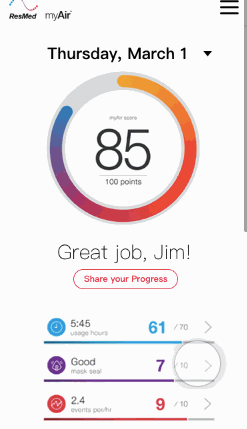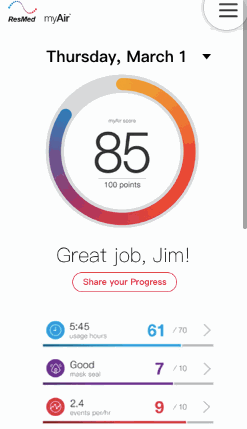VIBA
ResMed
Improving sleep therapy adherence
through peer coaching
Challenge
25 million Americans are afflicted by sleep apnea. The problem has only gotten worse over the past two decades.
Although sleep apnea therapy is proven to be effective, consistency can be challenging. Lapses in therapy adherence are recognized as the primary barrier to successfully improving the chronic disease.
Solution
A mobile service that increases therapy adherence by shifting the focus to peer coaching and establishing a forum to share community knowledge.
Our strategy aims to harness the power of positive peer support groups to transition from the current model of self-management to community support. Our service also streamlines access to the company's existing online resources through a conversational user interface.
My Role
Research
Wireframing
Visual Design
Duration
3 weeks
Type
Mobile App
Service Design
Team
Melodie Yashar
Xu Wang
CLIENT
ResMed is a manufacturer of medical equipment for managing sleep-disordered breathing, chronic obstructive pulmonary disease, and other chronic diseases.



Peer Coaching
Conversational
User Interface
User Forum



Sharing community
knowledge creates value for both patients and ResMed
Enhanced exposure to online resources increases awareness
Feature
Peer Coaching
Patients are connected with others based on their therapy adherence.


VALUE
Peer supported engagement leads to better health outcomes.
Patients are connected with peers who have both higher and lower scores so they can both receive support and provide encouragement.
Feature
User Forum
Patient support is now carried out in a public forum, increasing the sense of community and eliminating the need for ResMed to repeatedly answer common questions and concerns.



VALUE
Patients are connected with peers who have both higher and lower scores so they can both receive support and provide encouragement.
Feature
Conversational User Interface
Patients can easily find resources through the use of SleepBot.


VALUE
The conversational user interface feature augments exposure to ResMed's extensive online educational resources that are difficult to locate.
Product Roadmap
A strategic plan to identify user groups, enhance features, and collect data to inform future investment, design, and development decisions.

Process
01
Stakeholder Mapping
Research
Qualitative Interviews
Competitve Analysis
02
Ideation
How might we?
Reverse Assumptions
Scenarios
03
Design
Paper prototyping
Wireframes
Visual Design
Discovery
Stakeholder mapping enabled us to understand all parties involved within our client's ecosystem.
We created a visual representation of all stakeholders to identify and delineate relationships. By mapping out our understanding of the ecosystem, we exposed ourselves to the breadth of parties involved and began to discover the complexities within the process of sleep therapy and respiratory care.
RESEARCH
We discovered that device set-up, education on using the device, and therapy adherence were ways we could provide value to all stakeholders.
Interview Insights
1. Respiratory therapists associated with distributors do not interface as closely with patients as they claim.
How might we?
We reframed our insights into How Might We questions to reconstruct challenges into opportunities for design.
How might we respond to users of ResMed products more quickly and efficiently?

After interviewing patients, respiratory therapists, clinicians, and doctors, we created a patient flow.




Doctor requests patient to take a CPAP titration test.
Patient is administered CPAP test in the lab.
If diagnosed, the doctor initiates the process of sleep therapy.
Patient contacts the insurance company to order the device.


Insurance company orders the device
from ResMed.
ResMed sends the device to a nearby Durable Medical Equipment company.

A respiratory therapist, sets up the device and educates patient on usage.

Doctor monitors patient data through a cloud-based system.
How might we lessen the burden on doctors and therapists for ensuring adherence?
2. Users have trouble with device hardware and find the experience of using a CPAP device in the long term bothersome and irritating.
How might we empower customers to feel more connected and improve their sleep on a daily basis?

Ideation
We began ideation by reversing our assumptions to create service ideas. We wanted to destabilize our conventional thinking pattern.
Conceptualization
Peer coaching is a big design opportunity. Social influence has the potential to instill behavior change within a group of individuals.
What if we used predictive analytics to connect individuals with similar score patterns? Creating a small meaningful relationship between two people who are trying to improve their sleep score would close the loop on patients feeling disconnected from the lack of follow-up from doctors and respiratory therapists.
Wireframes
After brainstorming a set of user flows, we designed wireframes to outline the structure and give form to our idea.

Final visual design
We created a high-fidelity prototype after rounds of iteration and testing.
The dashboard displays the user's nightly sleep score, and is updated real-time each day.
The user can access the service through the Community section.
The user is matched with a peer of a similar sleep score, and can send encouragement or tips.
The user forum provides a way for patients to share feedback with peers and doctors.
Users can connect with and support multiple peers at a time.
Dashboard

Navigation

Find a Buddy

User Forum


Sleep Bot

The user can text or speak with SleepBot to have questions answered.
My Buddies

Support

Support is available through SleepBot, popular tutorials and trending posts.
© designed by Viba Subramaniam 2018